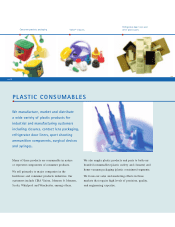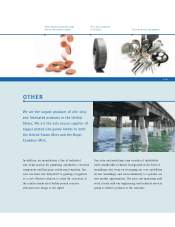Sunbeam 2002 Annual Report Download - page 20
Download and view the complete annual report
Please find page 20 of the 2002 Sunbeam annual report below. You can navigate through the pages in the report by either clicking on the pages listed below, or by using the keyword search tool below to find specific information within the annual report.Jarden Corporation
Management’s Discussion and Analysis (Continued)
Recent Developments
In January 2003, we filed a shelf registration statement, which was declared effective by the Securities and
Exchange Commission (the ‘‘Commission’’) on January 31, 2003. This shelf registration statement is intended
to facilitate our access to growth capital for future acquisitions and allows us to sell over time up to $150
million of common stock, preferred stock, warrants, debt securities, or any combination of these securities in
one or more separate offerings in amounts, at prices and on terms to be determined at the time of the sale.
On February 7, 2003, we completed our acquisition of the business of Diamond Brands, Incorporated, and
its subsidiaries (‘‘Diamond Brands’’), a manufacturer and distributor of kitchen matches, toothpicks and retail
plastic cutlery under the Diamond
®
and Forster
®
trademarks, pursuant to an asset purchase agreement. The
purchase price of this transaction was approximately $86 million in cash, net of cash on hand at Diamond
Brands, paid at closing and a deferred payment in the amount of $6 million payable in cash or our common
stock, at our election, on or before August 7, 2003. In connection with this acquisition, we amended our New
Credit Agreement, increasing our term loan facility by $10 million and our revolving loan facility by $20
million. We used cash on hand and draw downs under our debt facilities to finance the transaction. As of
December 31, 2002, approximately $1.5 million for an escrow deposit and expenses related to the Diamond
Brands acquisition had been capitalized and included in our balance sheet. Following this acquisition and the
effectiveness of our amendment, we had outstanding $57.5 million under our term loan facility and $14 million
under our revolving credit facility. After taking account of the outstanding amount and issued letters of credit,
we had approximately $45.8 million of availability remaining under the revolving credit agreement.
Critical Accounting Policies
Our financial statements are prepared in accordance with accounting principles generally accepted in the
United States, which require us to make judgments, estimates and assumptions that affect the amounts reported
in the financial statements and accompanying notes. The following list of critical accounting policies is not
intended to be a comprehensive list of all our accounting policies. Our significant accounting policies are more
fully described in the notes to our consolidated financial statements. The following represents a summary of our
critical accounting policies, defined as those policies that we believe are the most important to the portrayal of
our financial condition and results of operations, and/or require management’s significant judgments and
estimates:
Revenue recognition and product returns
We recognize revenue when title transfers. In most cases, title transfers at the time product is shipped to
customers. We allow customers to return defective or damaged products as well as certain other products for
credit, replacement, or exchange. Our revenue is recognized as the net amount to be received after deducting
estimated amounts for product returns, discounts, and allowances.We estimate future product returns based
upon historical return rates and our judgment. If these estimates do not properly reflect future returns, they
could be revised.
Accounts receivable
We maintain an allowance for doubtful accounts for estimated losses that may result from the inability of
our customers to make required payments. If the financial condition of our customers were to deteriorate or our
judgment regarding their financial condition was to change negatively, additional allowances may be required
resulting in a charge to income in the period such determination was made. Conversely, if the financial
condition of our customers were to improve or our judgment regarding their financial condition was to change
positively, a reduction in the allowances may be required resulting in an increase in income in the period such
determination was made.
Inventory
We write down our inventory for estimated obsolescence or unmarketable inventory equal to the
difference between the cost of the inventory and the estimated market value based upon assumptions about
PG. 18
























